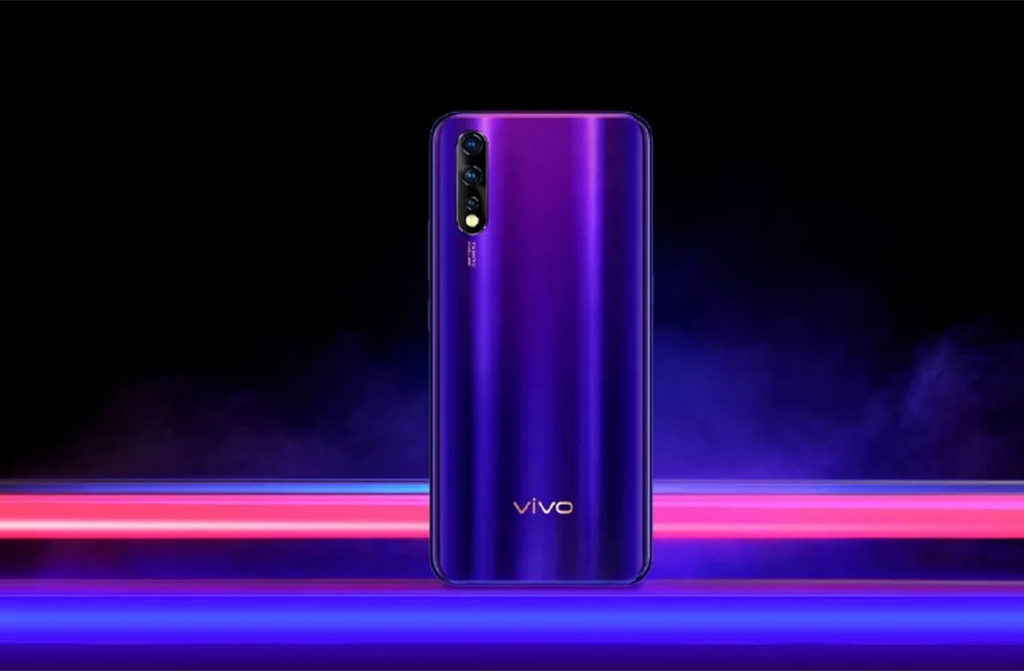Vivo Z5i smartphone review with key features

In November 2019, the Chinese company Vivo launched a new model Z5i on the international market, which is a lightweight version of the previous Z5. The smartphone belongs to the budget category, however, for the declared price of 230 euros, it includes many advantages. Details regarding detailed characteristics and features are found below in the article.
Brief information
The manufacturer Vivo has once again proved that their manufactured models do not particularly differ in appearance and characteristics, but it is worth giving them their due, since the gadgets are of low cost. As for the Z5i model, it practically does not differ from its predecessor. The main changes include a more capacious battery, installation of a microSD slot, a larger display diameter and improved performance of the proprietary shell. Otherwise, this is the same Z5 with a quality display, impressive color reproduction and high pixel density. Of course, there were some changes for the worse, since the main sensor of the rear camera sank in quality. They also installed a weaker chipset, and moved the finger scanning sensor to the rear panel. But despite the shortcomings, the Z5i is worthy of attention.
Specifications
| Parameters | Specifications |
|---|---|
| Display diagonal | 6.53 inch |
| Display resolution | 1080 x 2340 pixels |
| Pixel density | 395 ppi |
| Aspect ratio | 19,5: 9 |
| Chipset | Snapdragon 675 |
| Graphics chip | Adreno 612 |
| RAM | 8 GB |
| Built-in memory | 128 GB |
| operating system | Android 9.0 (Pie) |
| Main camera | 16 MP / 8 MP / 2 MP |
| Front-camera | 16 megapixels |
| Battery capacity | 5000 mAh |
| Fast charging | 18 watts |
| Dimensions | 162 x 76.5 x 8.9 mm |
| Weight | 193 g |
| release date | November, 2019 |
| Colour | Blue, black |
| The cost | 230 euros |
Design and ergonomics
The smartphone is made of durable glossy plastic with a glass insert. The material can hardly be called practical by the standards of 2019, but there are no other options for the budget model. On the other hand, the plastic looks attractive when you consider the available colors. The phone is available in jade blue and glazed black.
The design is assembled with high quality, since the plastic panel sits rigidly in the hands, and the controls do not dangle at all. At moderate loads, the device behaves with dignity. The back cover does not creak, and the connectors do not play. End surfaces are of particular interest. To the touch, the material resembles metal inserts.
In terms of dimensions, the Z5i has noticeably improved, as its weight is now 193 grams. The case is 162 mm high, 76.5 mm wide and 9 mm thick. Compared to its predecessor, the model has become significantly thicker.

The layout of the controls has not changed. On the right side there is a power button and a volume control, and on the left there is a tray for two NanoSIMs and a microSD slot built into it.Also on the end surface there is a button for launching a virtual assistant with voice control. At the bottom there is a port for charging the phone and a standard 3.5 mm headset jack.
The front panel is equipped with a 6.53-inch screen and a front-facing camera that sits at the top in a waterdrop notch. The back cover houses the main camera with three sensors, an LED flash and a fingerprint scanner. As with the previous model, there is no notification light, but the system has an Always-on-Display option with individual settings.
Display
The main feature of the smartphone is considered to be a 6.53-inch display, which occupies 84.5% of the area on the front panel. The device has an IPS LCD matrix of 16 million colors. The screen resolution is 2340 x 1080 pixels, and the aspect ratio is 19.5: 9. The pixel density is 395 ppi, which is slightly less than the Z5 (404 ppi).

The picture on the display is very bright, so the content on the screen does not lose quality even in daytime sunny colors. The minimum brightness level can be adjusted so that night reading will not hit the eyes. Color rendition can be adjusted in the advanced screen settings. The image is always saturated, especially the white color, which does not look faded.
Iron and performance
The Vivo Z5i smartphone operates under the leadership of the Qualcomm SDM675 Snapdragon 675 chipset, which is built on an 11 nanometer process technology. The platform runs a 2-core Octa-core Kryo 460 Gold processor at 2 GHz and a 6-core Kryo 460 Silver at 1.7 GHz. As you can see, the chipset is much weaker than that of its predecessor, since the previous model has a Qualcomm SDM712 Snapdragon 712 installed. Despite the budget category, the platform copes with demanding tasks thanks to a cold energy efficient processor. The device can be purchased in one configuration: 128 GB of internal memory and 8 GB of RAM. The main advantage of the lite version is the presence of a memory slot that supports microSD up to 256 GB. The read and write speed of the built-in memory is relatively good - 498/188 MB / s, respectively. The RAM shows not the best results - 11 GB / s.
The graphics processor Adreno 612 is responsible for the visual component. Together with the central processor, which emits a low amount of heat, the video chip copes well with gaming applications. The best representatives of the mobile gaming industry Shadow Gun and PUBG work at maximum settings without sagging FPS. Of course, after 4-50 minutes, the GPU power figures dropped by 15%, but this did not affect the performance.
Autonomy of work
An unexpected plus in the device was the increase in battery capacity. A 5000 mAh battery is installed on board, which is quite enough for three days of continuous operation. Of course, there is also a minus in this situation, since the fast charging function decreased in power to 18 W, when the Z5 was 22.5 W. Under these circumstances, the device will take 30 minutes longer to charge, with a total of 1 hour 50 minutes to recharge.

operating system
The software in the device is the Android 9.0 OS with the proprietary Funtouch 9.2 interface. As for the shell, it has undergone a noticeable change, resulting in improved operating system performance. For example, gesture controls are more responsive to hand touches. The work of the virtual assistant has also accelerated, where voice control has become clearer to receive commands. The fingerprint scanner responds much faster than the Z5i.
Camera
Compared to its predecessor, the Vivo Z5i has a budget camera and, accordingly, the picture quality will be much worse. There are three modules on board:
- main 16 MP with luminous power f / 1.8 PDAF;
- ultra-wide at 8 MP with an aperture of f / 2.2;
- 2 MP depth sensor with f / 2.4 aperture.
Photos taken with a wide module are of mediocre quality with questionable levels of brightness and saturation. The portrait mode does not inspire positive impressions, as the detail is rather low. At night, the camera copes poorly. Using the backlight, shots come out with clear grain and poor detail. When daylight is good, then you can create a normal photo, but under different circumstances the camera is clearly inferior to its predecessor.

The front camera has also undergone a downgrade, since the module now has not 32 MP, but 16 MP with f / 2.0 light power. There is a portrait mode in the front lens, and the pictures are of higher quality than on the main camera. Video recording supports Full HD + format. The videos come out not very detailed, plus the sound is very lame. This is especially true in poor lighting conditions.
Sound system
The sound quality is average. Mostly high frequencies are heard with a complete lack of sonic depth. The situation is saved by an additional headset, thanks to which in the device settings you can choose an individual sound style. The sound itself is loud, but there is very little bass.

With the spoken speaker, things are much better, since the interlocutor is heard well. The volume is also high, there is no interference or distortion.
Communication and communications
The smartphone system supports two nanoSIM cards with all communication standards. The tray is hybrid, so a memory card is installed in addition. There are USB On-The-Go and microUSB 2.0 ports. The device is equipped with Bluetooth technology with a data transfer rate of 5 MB / s and a dual-band Wi-Fi 802.11 a / b / g / n / ac module. There is support for connecting with satellites BDS, GLONASS and A-GPS. Cold start is 5 seconds. A radio receiver acts as a multimedia add-on. There is no contactless payment module in the phone.
Advantages and disadvantages
- Large 6.53-inch display
- High image quality;
- IPS LCD matrix with good detail and pixel density;
- Support for memory cards up to 256 GB;
- Modified proprietary shell Funtouch 9.2;
- Capacious battery - 5000 mAh;
- Powerful chipset and graphics processor;
- Fast fingerprint scanner;
- Support for demanding gaming applications;
- High speed of writing files in internal memory.
- Low cost - 230 euros;
- Nice appearance.
- Weak rear camera;
- Poor sound quality;
- Low speed of RAM;
- Fast charging at 18W;
- Lack of NFC;
- Large weight and thickness of the case.

Output
Based on the information provided, it becomes clear that Vivo did not have to let the Z5i smartphone in. The main problem of the phone is its secondary nature. There are no significant changes or innovations that could be noted against the background of the Vivo Z5 at the same price. A more capacious battery and support for a memory card pleases, but a very weak camera kills a positive impression, the pictures of which look ridiculous on such a large display.
new entries
Categories
Useful
Popular articles
-

Top rating of the best and inexpensive scooters up to 50 cubic meters in 2020
Views: 97661 -

Rating of the best materials for noise insulation for an apartment in 2020
Views: 95022 -

Rating of cheap analogues of expensive medicines for flu and colds for 2020
Views: 91751 -

The best men's running shoes in 2020
Views: 87680 -

Top ranking of the best smartwatches 2020 - price-quality
Views: 85091 -

Best Complex Vitamins in 2020
Views: 84801 -

The best dye for gray hair - 2020 top ranking
Views: 82406 -

Rating of the best wood paints for interior use in 2020
Views: 77202 -

Ranking of the best action cameras from China in 2020
Views: 75269 -

Rating of the best spinning reels in 2020
Views: 74827 -

The most effective calcium supplements for adults and children in 2020
Views: 72462 -

Top rating of the best means for male potency in 2020 with a description
Views: 68296









